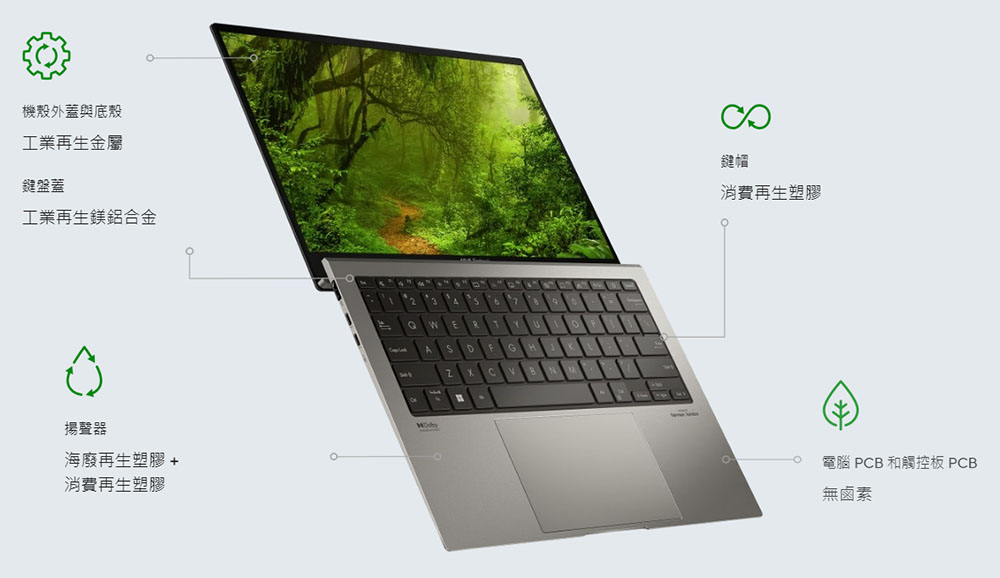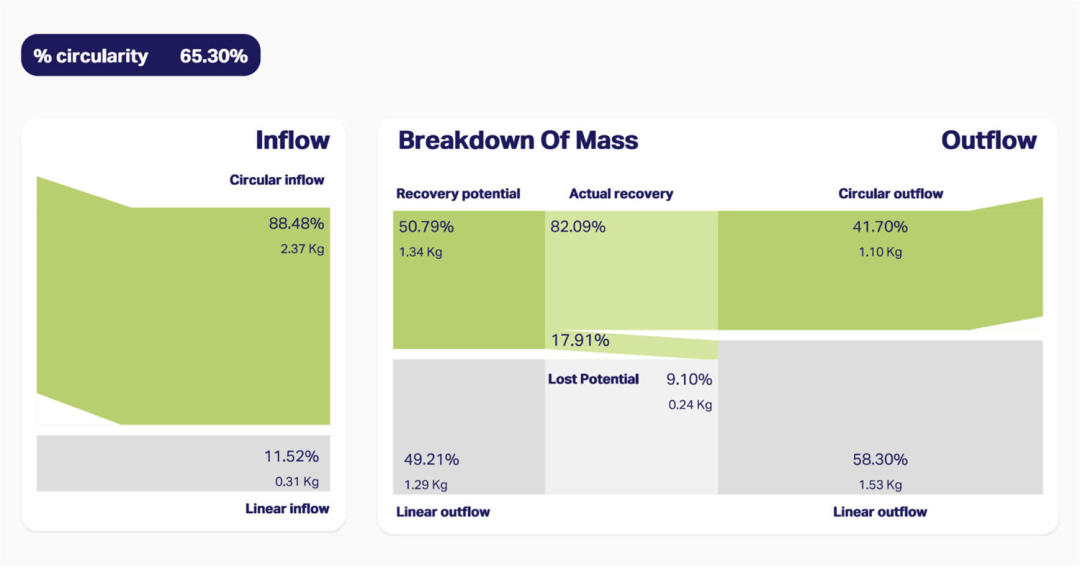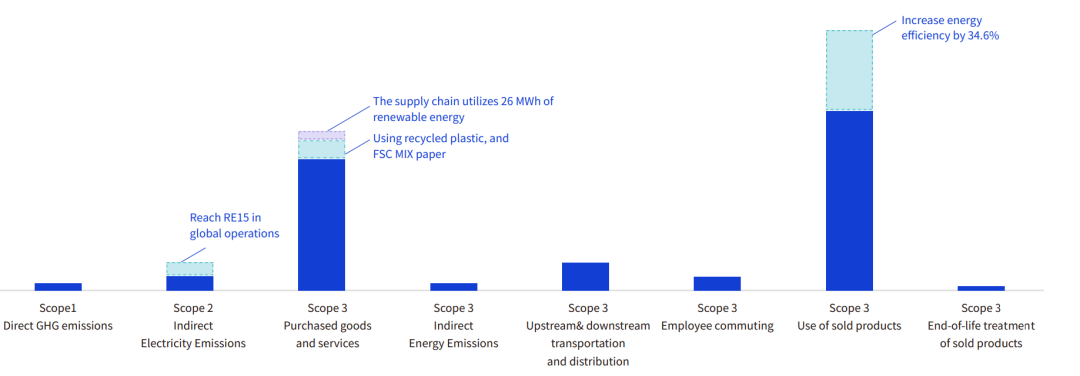Design Low-Carbon Products by Incorporating Circular Economy Principles | Latest Information | ASUS ESG website, ASUS ESG goal
Feature Story
2024/01/26
Design Low-Carbon Products by Incorporating Circular Economy Principles
-
Copied to clipboard
reduction in Scope 3 emissions associated with use of sold products.
increase in environmentally friendly materials.
Summary
Design low carbon products by incorporating circular economy principles into product design focusing on eco-friendly materials & energy efficiency.
Content
ASUS' sustainability actions focus on climate action, circular economy, responsible manufacturing, and value creation. The four key sustainability focuses extended our commitment to the environment and society.
Among them, circular economy represents a system's transformation that aims to reduce the environmental impact along the product's entire life cycle: from product design to manufacturing and use. ASUS has established environmental product design principles to incorporate circular economy thinking into product and service design and reduce product carbon footprint.
As part of its circularity commitment ASUS has set ambitious goals to promote sustainable procurement and double the use of environmentally friendly materials in products and packaging by 2025 compared to 2020, as defined in ASUS Sustainability Report 2022. The company also aims to reach a recycling rate of 20% for its products across the world. To attain these objectives, ASUS is among others, replacing virgin materials with secondary (non-virgin materials), setting up take-back schemes to collect broken laptops and improving critical recycling infrastructure.
Solution
1. Set baseline and identify areas for improvement.
To gauge its progress toward achieving circular economy goals, ASUS used the Circular Transition Indicators (CTI) v4.0 (1), a comprehensive framework of circularity metrics developed by the World Business Council for Sustainable Development (WBCSD). Using this framework, ASUS established a baseline of current circular performance and identified areas for improvement in closing materials loops of the laptop Zenbook S13 OLED.
The CTI indicator that the company selected was the % material circularity indicator. This indicator expresses the effectiveness of a company in closing its material loops by measuring the company's ability to minimize resource extraction and waste materials. For the product design team, this meant analyzing the current materials used in the laptop and identifying opportunities to substitute linear materials with environmentally friendly, circular ones. Leveraging this framework ASUS identified where to increase the percentage of recycled plastics & metals, and optimize the packaging.
2. Design low-carbon circular products
Figure 1 shows the circular design as a result of using the Circular Transition Indicators.

ASUS uses ISO 14040 and 14044 Life Cycle Assessment (LCA) methods to quantify potential environmental impacts. To reduce the carbon footprint generated by products throughout their lifecycle, ASUS incorporates a circular strategies into product design and services. This includes the use of environmentally friendly materials and improving product energy efficiency.
- Environmentally friendly materials
Among ASUS products, mainstream products contain more than 30% plastic of total weight, which accounts for the largest amount of materials used. Therefore, Asus cooperates with suppliers to explore the opportunities that increase the use of post-consumer recycled (PCR) plastic as much as possible without compromising quality, function, and durability. ASUS does this by communicating with suppliers about the individual carbon coefficients of various PCR material sources to select the most suitable PCR materials for ASUS. Since 2017, ASUS has used more than 1,689 tonnes of PCR plastic and reduced carbon emissions by 11,607 tonnes CO2e. In 2022, ASUS began to try a more diverse range of environmentally friendly materials. For example, ASUS used 30% post-industrial recycled metal in the metal casing of our business laptop ExpertBook B9.
Since 2019, 90% of paper packaging materials have been made of recycled pulp. Approximately 21,039 tonnes of recycled paper was used for main products in 2022. Moreover, ASUS has started to use paper materials from Forest Stewardship Council (FSC), and use a total of 71.7 tonnes in 2022.
- Product Energy Efficiency
ASUS’s laptops use power supplies with high energy efficiency levels available on the market, Level VI. We also set the internal specifications 10% stricter than legal requirements when the product is in the power off status to reduce power consumption. The commercial and consumer laptops launched by ASUS in 2022 exceed the ENERGY STAR® standard by an average of 34.6%.
3. Continued optimization & end-of life
To optimize end-of-life, ASUS provides recycling services in 30 countries, including drop off, mail back, trade-in, and pick up. To increase recovery of materials when it is collected, ASUS implemented a modular design of the laptop that is easy to disassemble and maintain.
Running the circularity assessment using CTI, provided precise guidance on how to incorporate more renewable resources, increase recyclability, and reduce the environmental impact of a laptop throughout its life cycle. With these interventions the company almost doubled the material circularity percentage of the Zenbook S13 OLED, going from 35% to 65% (Figure 2). Circular inflow, which expresses the percentage of secondary and renewable resources of the total purchased materials, now stands at 88.48%. Circular outflow measures what percentage of materials get recovered after end-of-life. The company improved its circular outflow by implementing a modular design of the laptop that is easy to disassemble and maintain.
ASUS highlights the value of CTI as an empowering decision-making framework that helps the company quantify and track and optimize circularity. ASUS was able to find the most suitable circular interventions, which led to a successful redesign of the laptop and the development of a "make-use-return" business model.

Impact
Climate impact
Targeted emissions sources
Scope 3:
- Category 1: Purchased goods and services
- Category 11: Use of sold products
Decarbonization impact
In 2022, ASUS implemented low-carbon product strategy by incorporating high energy efficiency designs. This initiative led to a remarkable 26% reduction in Scope 3 emissions associated with the use of sold products. Furthermore, by using eco-friendly materials, including post-consumer recycled plastics (compared to using virgin plastic, using PCR can reduce carbon emissions by 20%), post-industrial recycled metals, FSC-certified paper, and by having suppliers utilize renewable energy sources, ASUS achieved a 0.3% reduction in Scope 3 emissions associated with purchased goods and services.
In addition, ASUS achieved annual goal for 2022, which was set in line with its 2025 climate sustainability targets, of “Key suppliers reduced GHG emissions intensity by 24% compared to baseline year". In 2022, the proportion of our suppliers in solar power generation increased by 8% compared to 2021, while the proportion in setting greenhouse gas reduction targets was up by 8% compared to 2021. 33% of suppliers obtained ISO 14064 third party verification, while 29% of them obtained ISO 50001 certification.

Business impact
Benefits
- Circular business impacts
- Reducing linear risks: Using recycled materials can reduce the risks associated with a linear economy. For example, it helps avoid supply disruptions caused by the scarcity of materials, and mitigates the impact of raw material price fluctuations on product costs. Furthermore, it helps prevent fines resulting from the gradual tightening of international regulations.
- New partnership for take-back infrastructure: ASUS had set up take-back scheme and provided diverse recycling services including setting up drop off, mail back, trade-in, and pick up services. This resulted in new partnerships. Through collaboration with local recyclers, in some cases, the waste reuse rate in the local market has increased.
- Competitiveness of Circular, Low Carbon Products: By using safer chemicals, environmentally friendly and recycled materials, lightweight packaging, excellent products energy efficiency, and along with the design of products that are easy to disassemble and repair, the revenue from ASUS Eco Friendly Products (obtaining one of the following eco labels:EPEAT, TCO, Taiwan Green Mark, China RoHS, Japan ECO mark, China Environmental Labeling, ENERGY STAR®, Taiwan Energy Label) was now account for 87.2% of revenue.
- Strengthen partnerships: It is enhancing the climate resilience of its suppliers and strengthening collaboration with universities and colleges through industry-academia partnership
Costs
The use of recycled raw materials comes with a relatively higher cost compared to virgin materials. Furthermore, to meet the quality standards for both materials and products, the introduction of new raw materials must undergo extensive testing and verification processes, contributing to an overall increase in production costs. These costs associated with materials and testing gradually decrease as procurement volume expands.
Implementation
Typical business profile
Circularity approaches in product design can be relevant for companies operating in the electronic products, packaging, automobile, and the textile industries.
Approach
To increase the circularity of the laptops, employees from all over the company need to come together. First, the R&D department plays a crucial role in imagining a circular design and conducted many engineering test of different surface treatments and alloy metal combinations to find the optimal circular material. Meanwhile, procurement and project teams evaluated the feasibility of production at scale.
The Business Unit's Project Manager (PM) coordinates product design and production planning, aligning them with market demands and eco labels’ prerequisites. The R&D Department holds a pivotal role in envisioning circular design concepts, extensively conducting engineering assessments on various surface treatments and alloy metal combinations to ascertain the most suitable circular materials. The Procurement Department supports the optimal procurement of eco-friendly materials. Simultaneously, cross-unit collaboration within the organization is ensured through the ESG committee with sustainability department acting as the committee coordinator. This guarantees the cohesiveness of the company's green product policy and its comprehensive implementation.
Stakeholders involved
The implementation of ASUS' circularity and low-carbon product design strategy involves the participation of the following corporate departments and stakeholders:
- Executive Management: Establishing the short, medium, and long-term sustainability strategy.
- Sustainability and Green Quality Management Center (sustainability dedicated department): Analyzing global sustainability trends and driving green product initiatives, setting greenhouse gas reduction goals.
- ESG Management Committee: Members include business units, design centers, certification, marketing, sales, etc., facilitating cross-functional coordination and the implementation of green product initiatives.
- Business Unit:
- PM (Project Manager): Develop product specifications and serve as project coordinator.
- R&D: Implement energy efficiency design and mechanical design.
- Procurement: Assist in selecting environmentally friendly materials
- Suppliers: Key suppliers participate in Carbon Reduction Engagement and Counseling Program, expand the use of renewable energy, and enhance energy efficiency.
- Consumers: Communicating ASUS' low-carbon sustainability initiatives, correct disposal of used electronics.
Key parameters to consider
- WBCSD’s Circular transition Indicators (CTI)
- Solution maturity: For example, energy efficiency design is a mature technology, and we will implement the most current standards or regulations as design principles. In contrast, environmentally friendly materials belong to established technology, and their introduction into products requires testing and verification.
- Technical limitations: Using the integration of environmentally friendly materials as an example, the materials need to comply with ASUS's HSF (Hazardous Substance Free) technical standards while ensuring their quality and durability, Consequently, there are specific limitations in the material selection process.
- Additional specificities: This includes compliance with regulations concerning hazardous substances and energy standards within eco-label requirements across diverse sales markets.
Going further
Reference: The Climate Drive
Related Article

